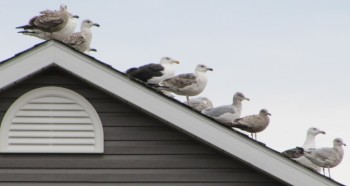The Mid-Winter Flocking of Lubec’s Seagulls
Posted 02/07/25
Maypole dancing, Scottish Reels, disco or rave: We gather in great groups, dance our hearts out, find a mate, raise a family, and retire. That is an entire lifetime for most people; our seagull friends repeat that ritual every year according to the mandates of spring phenology—that is the seasons being defined by conditions rather than calendars. Gulls flock for safety, food, migration, and mating.* Early March, winter just breaking, they gather in great flocks, whirl, dip, dive, caw, cry, and mew their song of life. Like many humans, most are already paired for life and this performance is a rekindling of the romance which brought them together. Then they go to their respective nesting sites, do their mating dance, have one, two, or three little chicks and life in the colony goes on. The chicks grow quickly, and they will be screaming for more food, more food, more food as mama and papa bring clams, sandworms, crabs and fish tirelessly until one day, the parental unit takes a stand and says, “Get your own damn clams.” The fledgling gulls gather in small tribes and leave the flock for a couple of years or more until they reach their maturity and join the spring flock looking to start a life.
Our seagulls of mid-January, here in Lubec, have been flocking as if March had arrived and the party is on. With the warming of the globe, we have pretty much lost real winter—snow sledding, dog sled races, heavy ice floes in the harbor, etc. Early spring-like weather has expanded, beginning in mid-December, popping up all the way through the traditionally very cold months of January and February, and confusing our seagull neighbors. Once, not too long ago, we would experience a “January thaw” and temperatures went up from a two week stretch of twenty below to a balmy thirty-two degrees (f) above and we all shed our parkas and reveled in the heat wave. Now we have a January freeze, when it gets into the single digits for a few days and we complain about how cold it is. The bird clocks are confused with the changing patterns of weather, as is my backyard, which has been trompled into a muddy spring-like mess well into January by Rhonda’s Wind Song ponies. It is expected to thaw again soon, unlike days of yore when the freeze extended three feet into the soil and the world stayed hard until ice-out in March or April.
But birds in general and seagulls in particular are an intelligent and very adaptable lot. I remember well a time when seagulls were under a lot of pressure due to changing circumstances: The open dump landfills, a solid source of nutrition for many gulls (and rats as well) were all closed; there were less fish by-products being cast into the water; and the eagles had rebounded magnificently, putting a real hurting on seabird nesting sites. I paddled around Nash Island back in the mid-eighties and I counted more eagles (30+) than I did the downy, pigeon sized chicks of the nesting gulls. I watched in horror as a pack of three eagles descended on a nest, plucked a plump gull chick from under the wings of the frantic parents and tossed it to and fro as it flapped and squawked bloody murder until one flew off with it to dine in solitary leisure. Since then the seagulls have adapted to this heavy predation and fared well. They can be found nesting in alleys and on rooftops in urban areas and eating french fries down at your local laundromat.
I will pray for the birds, invite you to join me, and hope that they don’t have babies in February and freeze in March. I’ll tell them to hold strong and make do while we try to get this rapidly warming world back in some predictable approximation of its natural order.
By: CA Kniffen
* “SEAGULLS! they don’t exist,” the birder soundly advised me and explained why this term is so maligned by birders and the danger of riling said birders if I were to use it. I gave it some thought, realizing that I, everyone I know and have known, and most publications that mention these birds, call them seagulls. And many public beaches have official DO NOT FEED THE SEAGULLS warnings. We have been using this word almost forever. (OED notes the noun “seagull” has been in use since the mid-1500’s) Doesn’t that make it a word? A word which points to a bird? I’m going to respect the traditional term “seagull” for the bird in question, knowing, as most people do, that there are many kinds: herring, great black-back, ring-billed, small, Bonaparte’s (don’t ask me), and so forth… I will leave the niceties of language usage and naming rights to others.
* When(ever) spring springs, the birds gather and many factors are at play: safety, food, warmer weather, and elevated hormone levels. Which is the driving factor for this spate of winter flocking is yet to be determined, but it has been determined that climate change has a pronounced effect on breeding patterns. Of course, in the Hitchcock thriller, The Birds, many species flocked together for the sole purpose of killing people. There is some allusion to them having ingested a “toxic algae” but that was a stab in the dark, just like this essay. Anomalies are anomalies because we don’t know why and we’re just taking our best guess based on current information. This is mine.

